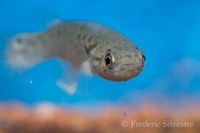ILEE Lunch Seminar
- https://ilee.unamur.be/events/ilee-lunch-seminar-31
- ILEE Lunch Seminar
- 2024-09-17T12:45:00+02:00
- 2024-09-17T14:00:00+02:00
- When Sep 17, 2024 from 12:45 PM to 02:00 PM (Europe/Brussels / UTC200)
- Where S07, Science building
-
Add event to calendar
 iCal
iCal
Romain Deleu (Geology): Solute transport in underground rivers: study of spatially heterogeneous breakthrough curves by multi-point dye tracing and 3D Computational Fluid Dynamics (CFD) simulations
 A tracer test is a field methodology widely used in hydrogeology, particularly to characterise underground flows in karstic environments. It involves injecting a tracer into a river, leak or well, a substance that can be detected downstream by a measuring device. The most common tracers are fluorescent substances such as fluorescein, which can be easily detected by field fluorometers. Conventional tracing methodology involves the use of a single fluorometer, which is often placed on the side of the river, close to the bank, for ease of access. The development of new compact, autonomous and inexpensive fluorometers has made it possible to carry out ‘multipoint’ tracings, i.e. tracings involving the use of several fluorometers placed across a section of underground river. Recent studies have shown that the position of the device seems to have a significantimpact on the quality of the result, and the aim of this thesis is to quantify the signal heterogeneities as a function of the position of the device. This methodology was applied to several karstic sites in Wallonia.
A tracer test is a field methodology widely used in hydrogeology, particularly to characterise underground flows in karstic environments. It involves injecting a tracer into a river, leak or well, a substance that can be detected downstream by a measuring device. The most common tracers are fluorescent substances such as fluorescein, which can be easily detected by field fluorometers. Conventional tracing methodology involves the use of a single fluorometer, which is often placed on the side of the river, close to the bank, for ease of access. The development of new compact, autonomous and inexpensive fluorometers has made it possible to carry out ‘multipoint’ tracings, i.e. tracings involving the use of several fluorometers placed across a section of underground river. Recent studies have shown that the position of the device seems to have a significantimpact on the quality of the result, and the aim of this thesis is to quantify the signal heterogeneities as a function of the position of the device. This methodology was applied to several karstic sites in Wallonia.
Justine Bélik (Biology): Can DNA methylation predict the age of a self-fertilizing vertebrate species?
 Efficient and accurate estimation of fish age is crucial to understand the demographic structure of populations and consequently population dynamics. Traditional estimation methods, such as counting growth increments in vertebrae or otoliths, require well-trained staff, are time-consuming and lethal. Several biological predictors have been studied, including telomere length, transcriptomic, proteomic or metabolomic predictors and DNA methylation, the latter being the most reliable. DNA methylation is a stable epigenetic mark that plays an important role in regulating gene. The epigenetic clock is based on systematic changes in methylation levels with age. It has already been determined for many vertebrates, including humans, and many teleost species. This study is the first to develop the epigenetic clock in an isogenic vertebrate lineage, the mangrove rivulus, Kryptolebias marmoratus. This small fish presents a mixed-mating strategy, where hermaphrodite individuals can self-fertilize, producing naturally isogenic lineage. It could be shown that the DNA methylation pattern evolves over the lifetime of the rivulus in the absence of genetic variation.
Efficient and accurate estimation of fish age is crucial to understand the demographic structure of populations and consequently population dynamics. Traditional estimation methods, such as counting growth increments in vertebrae or otoliths, require well-trained staff, are time-consuming and lethal. Several biological predictors have been studied, including telomere length, transcriptomic, proteomic or metabolomic predictors and DNA methylation, the latter being the most reliable. DNA methylation is a stable epigenetic mark that plays an important role in regulating gene. The epigenetic clock is based on systematic changes in methylation levels with age. It has already been determined for many vertebrates, including humans, and many teleost species. This study is the first to develop the epigenetic clock in an isogenic vertebrate lineage, the mangrove rivulus, Kryptolebias marmoratus. This small fish presents a mixed-mating strategy, where hermaphrodite individuals can self-fertilize, producing naturally isogenic lineage. It could be shown that the DNA methylation pattern evolves over the lifetime of the rivulus in the absence of genetic variation.

Please order your sandwich until Monday, 16.09. - 10h!
carolin.mayer@unamur.be
 Institute of Life, Earth and Environment
Institute of Life, Earth and Environment
